Gray Snapper
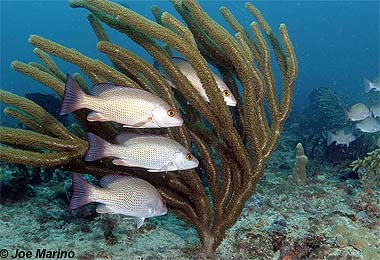
Lutjanus griseus
This is one the smaller and slimmer of the snapper family, rarely growing larger than 18 inches long and 10 pounds. They are generally gray with darker dorsal and caudal (tail) fins, but can display wide variations of small spots, pale bars, or fin tip coloring based on age and living conditions. They live in both coastal and offshore areas of coral, rocky ledges, or mangroves, and have been caught in freshwater lakes, showing their tolerance for different salinity levels.
Order: Perciformes
Family: Lutjanidae
Genus: Lutjanus
Species: griseus
Common Names
Common names in the English language include gray snapper, gray silk, mangrove snapper, mangrove pargue, mango snapper, pargue , black pargue, black snapper, lawyer, silk, and snapper. Other common names are caballerote (Spanish), caranha (Portuguese), caranjitu (Papiamento), carde gris (French), castanhola (Portuguese), grijze zeebars (Dutch), luciano (Portuguese), lujan trujacy (Polish), lutianido (Italian), napsija (Finnish), nezumifuedai (Japanese), pagre (French), pargo (Spanish), pargo de mangel (Spanish), pargo denton (Spanish), pargo manglero (Spanish), pargo prieto (Spanish), parguette (French), sarde grise (Creole), schnapper (German), sinagrida (Greek), tarumi feudai (Japanese), vivaneau sarde grise (French).
Importance to Humans
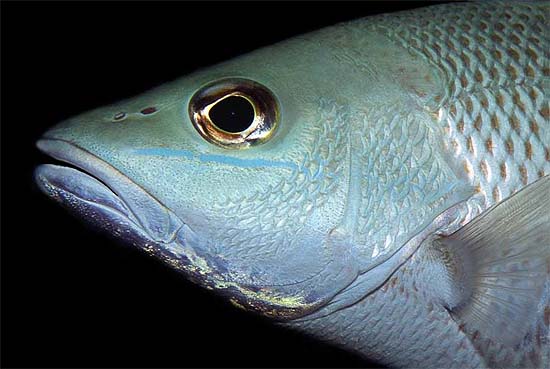
This snapper is a tremendously popular game and food fish, composing a major portion of both the sport and recreational catches of Florida’s snapper fishery. Although the species is fished commercially it is sought largely as a seasonal supplement to other fisheries. These fish are caught with beach seines, gill nets, traps, angling gear, handlines, and spears. Shrimp trawlers account for a large portion of the fishing mortality of this snapper, as the soft bottom habitats preferred by juvenile gray snappers also support large populations of shrimp. This fish has been successfully reared in aquaculture and is also exhibited in commercial aquariums.
As with many other tropical predatory reef fishes, ciguatera poisoning as a result of consuming this species has been documented. Such instances however, are rare.
Conservation Status
The gray snapper is not listed by the World Conservation Union (IUCN) as being in any immediate conservation threat. The IUCN is a global union of states, governmental agencies, and non-governmental organizations in a partnership that assesses the conservation status of species.
> Check the status of the gray snapper at the IUCN website.
Geographical Distribution
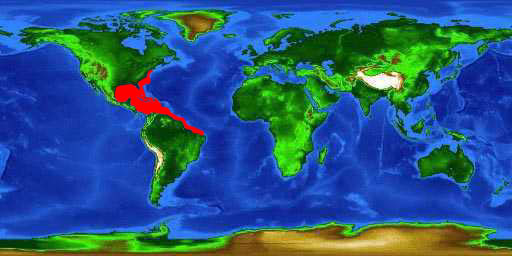
The gray snapper is found in the western Atlantic Ocean from Massachusetts to Bermuda, southward to Brazil, including Bermuda, Bahamas, West Indies, Gulf of Mexico and Caribbean Sea. It is especially abundant around the coastline of Florida.
Habitat
Gray snappers reside in coastal as well as offshore waters from very shallow areas to depths of 180m (585 feet). Large aggregations of this snapper are frequently observed amongst coral reefs, rocky areas, estuaries, and mangrove habitats. Adults of the species tend to remain in the same area for long periods once established and tagging studies have shown little movement for periods of time as great as 4 years. However, within such a range the species exhibits daily activity patterns associated with nocturnal feeding and diurnal schooling. Young gray snapper live inshore in areas such as seagrass beds as well as soft and sand-bottom areas but may be found in a variety of habitats and a number of inshore habitats are important nurseries for this species. Both adults and juveniles have been found in freshwater lakes and rivers in south Florida, a clear indication that the species is tolerant of a broad range of salinity levels.
Biology
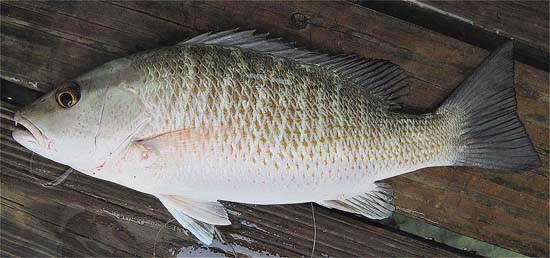
Distinctive Features
The gray snapper has a relatively slender body, a large mouth, and a pointed snout. The anal fin is rounded and the pectoral fins short, not reaching the anal fin. Young cubera snapper (Lutjanus cyanopterus) may be easily confused with gray snapper and careful comparison of the vomerine teeth (found on the roof of the mouth) of either species is the most reliable means of discerning the two. Adult cuberas however, are among the very largest of snapper species, obtaining lengths as great as 5 feet (1.5m) and weights of 125lbs (55.5kg) and such specimens are not likely to be confused for gray snapper! Male and female gray snapper are externally indiscernible.
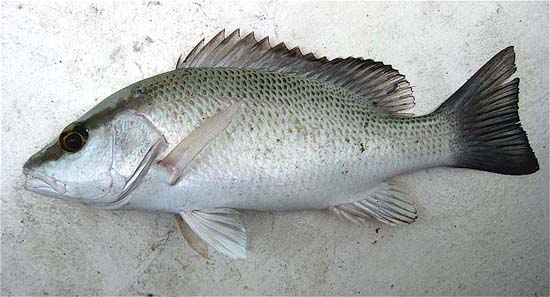
Coloration
Although the general ground color for this species may vary, especially so in the case of juveniles, in general the body and fins of gray snappers are gray to green with a reddish tinge. Evident on the sides of the fish are rows of small reddish to orange spots. The median fins are darker than the paired fins, often edged with yellow or white and the pectoral fins are colorless. The back edge of the anal fin is rounded. There is no black spot on the side of body. Young gray snappers have a prominent dark stripe from the snout through the eye and a less conspicuous blue stripe on the cheek, below the eye. They may also at times show a lateral pattern of narrow pale bars on the body. The fins of juveniles are reddish-orange with dark edges.
Dentition
Both jaws have a narrow band of villiform (fine, densely packed hair-like) teeth, while the upper jaw contains four strong canine teeth, two of which are enlarged and easy to see.
Size, Age, and Growth
The gray snapper is one of the smaller snappers, rarely exceeding 18 inches (45 cm) in length, and is almost always less than 10 pounds. Maximum size is 24 inches and 10lbs. Sexual maturity is obtained after about 2 years of age, at lengths of 7-13 inches (18-33 cm) and the estimated maximum age for this snapper is 25 years.
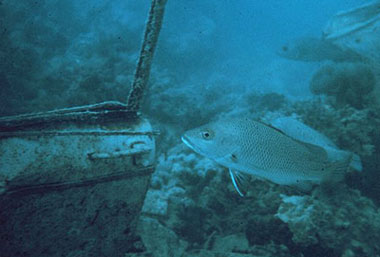
Food Habits
Gray snapper are opportunistic predators. Larvae feed on zooplankton including copepods and amphipods. Juvenile gray snappers feed by day among seagrass beds, mainly on crustaceans and fish and to a lesser degree polychaete worms and molluscs. Foraging nocturnally, adult gray snapper prey upon small fishes, shrimps, crabs, gastropods, and cephalopods.
Reproduction
Spawning occurs from April to November with a peak during the summer months, and is influenced by the lunar cycle. Individual snappers may spawn multiple times during the course of the reproductive season. Gray snapper spawn in aggregations during the times surrounding the full moon. The species is a broadcast spawner of demersal eggs from which hatch sparsely pigmented larvae approximately 20 hours post-fertilization. The yolk sac is absorbed within the first 45 hours, after which the larvae must actively feed amongst the plankton. Although little is known about larval snappers in general, most appear to be planktonic at lengths less than 10mm. The post-larval gray snapper typically settle into suitable estuarine habitats such as seagrass beds and mangroves, although they are known from a variety of habitats. Estuarine nursery areas offer rich sources of food as well as protection from predators. The pre-juvenile and juvenile snapper feed by day until they achieve a size of approximately 80mm around which time they move into shallow rocky areas and the coastal reefs where they are commonly found as adults.
Predators
Natural predators of all life stages of this snapper are numerous and include sharks, barracuda, grouper, moray eels and other snapper species.
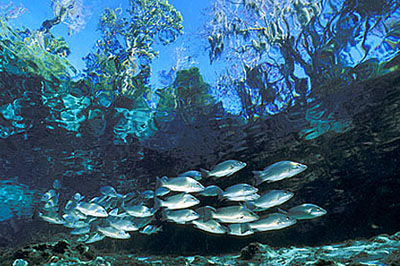
Parasites
Gray snappers host a variety of parasitic intestinal trematodes. The particular species of trematode that parasitizes any given fish is dependent a number of factors. Of particular importance are the habitat and prey of the fish, even migratory responses of the host to cold water. The following species are recorded trematode parasites of gray snappers: Metadena adglobosa, Metadena globosa, Metadena obscura, Paracryptogonimus neoamericanus, Hamacreadium mutabile, Hamacreadium gulella, Helicometrina nimia, Helicometrina exacta, and Stephanostomum casum. The copepod Caligus bonito, found on the body surface and on the wall of the branchial cavity, also parasitizes the gray snapper.
Taxonomy
Lutjanus griseus, the gray snapper, was described by Linnaeus in 1758. The species name is Latin, translated as gray. Synonyms include Sparus tetracanthus Bloch 1791, Lutjanus cabellerote Bloch and Schneider 1801, Anthias cabellerote Bloch and Schneider 1801, Bodianus vivanetus Lacepede 1803, Lobotes emarginatus Baird and Girard 1855, and Lutjanus stearnsii Goode and Bean 1878.
Prepared by: Cathleen Bester